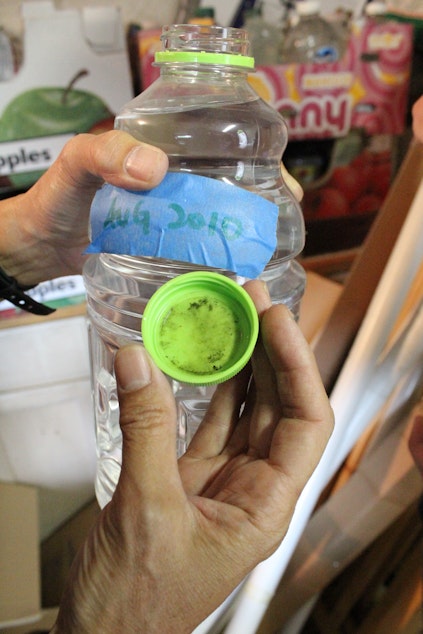Mouldy Water Bottle
Picture this: you reach for your trusty water bottle, ready to quench your thirst. But wait! As you unscrew the cap, an unsettling sight greets your eyes – a mouldy water bottle. Yikes! It’s a common problem that nobody wants to encounter. But fear not, because I’m here to help you understand why it happens, how to prevent it, and what to do if you find yourself in this slimy situation.
So, what causes a water bottle to become mouldy in the first place? Well, it’s all about moisture and darkness teaming up to create the perfect breeding ground for those pesky mould spores. When you forget to clean your bottle regularly or leave it closed without proper ventilation, the moisture inside can linger, making it a friendly habitat for mould to thrive.
But don’t fret! There are simple steps you can take to prevent mould growth and keep your water bottle fresh and clean. From regular cleaning and drying to choosing the right materials, I’ll guide you through the do’s and don’ts of maintaining a mould-free water bottle.
And if you already find yourself face to face with a mouldy water bottle, don’t panic! I’ll share some effective methods to safely clean and sanitize your bottle, ensuring it’s ready to serve up clean and refreshing hydration once again. So, let’s dive in and tackle the issue of mouldy water bottles head-on!
Step 1: Fill the bottle with equal parts water and vinegar.
Step 2: Let it sit for about 10-15 minutes.
Step 3: Scrub the bottle with a bottle brush.
Step 4: Rinse it thoroughly with warm water.
Step 5: Leave it to air dry completely.
By following these simple steps, you’ll have a clean, fresh water bottle in no time!

Understanding the Dangers of a Mouldy Water Bottle
Water bottles are a staple in our daily lives, allowing us to stay hydrated wherever we go. However, if not properly cared for, these seemingly harmless vessels can become breeding grounds for mould and other harmful bacteria. A mouldy water bottle not only affects the taste and odor of the water, but it can also pose serious health risks if consumed. In this article, we will delve into the dangers of a mouldy water bottle and provide you with tips on how to prevent and handle this common issue.
The Health Hazards of Drinking from a Mouldy Water Bottle
When a water bottle is left unattended and moisture is present, it creates an ideal environment for mould to grow. Mould thrives in warm and damp conditions, so if you’ve ever left your water bottle in a hot car or forgot to empty it before you went on vacation, it’s important to inspect its condition before using it again.
One of the major health hazards associated with drinking from a mouldy water bottle is the potential exposure to mycotoxins. Mycotoxins are toxic substances produced by certain types of mould that can contaminate the water and pose a risk to human health. Ingesting mycotoxins can lead to a range of symptoms, including respiratory issues, allergic reactions, headaches, and even long-term complications.
Furthermore, mould can also compromise the immune system, making you more susceptible to infections and illnesses. Those with pre-existing respiratory conditions, such as asthma, may experience exacerbated symptoms when exposed to mould. In severe cases, prolonged exposure to mould spores can cause lung infections and other serious respiratory conditions.
Tips for Preventing and Handling a Mouldy Water Bottle
Prevention is the key when it comes to dealing with a mouldy water bottle. By following these simple tips, you can maintain a clean and bacteria-free drinking vessel:
1. Wash your water bottle thoroughly after every use: Use warm soapy water and a bottle brush to scrub the inside of the bottle, including the cap and any crevices where mould may hide. Rinse it well and allow it to air dry completely before using it again.
2. Avoid prolonged exposure to heat: High temperatures can accelerate mould growth, so it’s best to avoid leaving your water bottle in hot cars, direct sunlight, or any other warm environments for extended periods.
3. Use a bottle with a wide mouth: Bottles with narrow openings can be harder to clean and dry effectively, providing a better environment for mould to thrive. Opt for a bottle with a wide mouth that allows for easy access and cleaning.
If you do discover mould in your water bottle, it’s essential to address the issue promptly. Here’s what you should do:
1. Dispose of the affected water bottle: If the mould growth is extensive or persistent, it is best to discard the water bottle to prevent further contamination and health risks.
2. Clean the surrounding area: After disposing of the mouldy water bottle, thoroughly wash and sanitize the area where it was stored to eliminate any lingering spores.
3. Monitor your health: If you accidentally consumed water from a mouldy bottle or have been exposed to mould for an extended period, monitor your health for any unusual symptoms. If you experience respiratory distress or severe allergic reactions, seek medical attention immediately.
By staying vigilant and adopting good hygiene practices when it comes to your water bottle, you can reduce the risk of mould growth and protect your health while staying hydrated on the go.
The Importance of Regular Cleaning and Maintenance
Regular cleaning and maintenance of your water bottle are crucial not only for preventing mould growth but also for ensuring the overall cleanliness and longevity of your bottle. Let’s explore the key reasons why you should prioritize these practices.
Preventing Bacterial Contamination
Mould isn’t the only culprit that can make your water bottle a breeding ground for bacteria. Without proper cleaning, residual water and beverage remnants can become a breeding ground for harmful bacteria that can cause gastrointestinal issues such as diarrhea and stomach infections.
Additionally, the moisture trapped inside a dirty water bottle can create an environment where bacteria thrive. This can lead to foul odors, a slimy residue inside the bottle, and an increased risk of bacterial infections.
Preserving the Taste and Quality of Your Beverage
A dirty water bottle can significantly affect the taste and quality of the beverages it holds. Bacterial growth and residue buildup can cause an unpleasant odour and alter the taste of your water or other drinks. This can make it less enjoyable to hydrate yourself throughout the day and might discourage you from drinking the recommended daily amount of water.
Extending the Lifespan of Your Water Bottle
Investing in a high-quality water bottle is a wise decision, but it also requires proper care to ensure it lasts for a long time. Regular cleaning and maintenance can help prevent the accumulation of stains, odours, and contaminants that could damage the bottle’s material and compromise its quality. By keeping your water bottle clean, you can extend its lifespan and get the most value out of your purchase.
Choosing the Right Water Bottle Material
When it comes to selecting a water bottle, the material plays a significant role in its durability, safety, and resistance to mould growth. Let’s explore some of the most popular options and their pros and cons.
1. Stainless Steel Water Bottles
Stainless steel water bottles are known for their durability and ability to keep beverages cold or hot for extended periods. They are resistant to mould, rust, and odours, making them an excellent choice for those looking for a long-lasting and safe option. However, they can be heavier and more expensive compared to other materials.
Benefits of Stainless Steel Water Bottles:
– Excellent durability and resistance to wear and tear.
– Retains the temperature of beverages for longer periods.
– Easy to clean and maintain.
– BPA-free, ensuring safe drinking water.
– Environmentally friendly, as they are reusable and have a long lifespan.
Drawbacks of Stainless Steel Water Bottles:
– Heavier compared to other materials, making them less suitable for travel or outdoor activities.
– More expensive upfront cost compared to other materials.
– May dent or scratch with rough use.
2. Glass Water Bottles
Glass water bottles are an eco-friendly choice that doesn’t impart any taste or odor to the beverages inside. They are easy to clean, recyclable, and have a sleek and visually appealing design. However, glass bottles are fragile and can break if dropped or mishandled.
Benefits of Glass Water Bottles:
– Chemical-free and non-toxic, ensuring the purity of your beverages.
– Retains the taste and quality of the drink.
– Easy to clean and sanitize.
– Transparent, allowing you to monitor liquid levels.
– BPA-free and environmentally friendly.
Drawbacks of Glass Water Bottles:
– Fragile and prone to breakage.
– Heavier than plastic or stainless steel bottles.
– Limited insulation properties, which may affect the temperature of your beverages.
3. BPA-Free Plastic Water Bottles
Plastic water bottles are light, affordable, and available in a wide variety of designs and sizes. However, it’s crucial to choose BPA-free options to ensure they are safe for use. BPA (Bisphenol A) is a chemical compound commonly found in certain types of plastic that can potentially leach into the water and have adverse health effects.
Benefits of BPA-Free Plastic Water Bottles:
– Lightweight and portable, making them ideal for travel or outdoor activities.
– Affordable and widely accessible.
– Variety of designs, shapes, and sizes.
– Good insulation properties, helping to maintain the temperature of your beverages.
– BPA-free, ensuring the safety of your drinking water.
Drawbacks of BPA-Free Plastic Water Bottles:
– Prone to scratches and wear and tear.
– Can retain odours and flavors if not cleaned properly.
– May leach chemicals into the water if exposed to extreme heat.
– Limited lifespan compared to other materials.
Tips for Cleaning and Maintaining Your Water Bottle
Keeping your water bottle clean and well-maintained is essential for your health and the longevity of the bottle itself. Here are some tips to help you maintain a clean and bacteria-free water bottle:
1. Wash your water bottle daily
Make it a habit to wash your water bottle thoroughly with warm soapy water after each use. Use a bottle brush to scrub the inside and remove any residue or stains. Don’t forget to wash the cap, as well as any other removable parts. Rinse the bottle well and allow it to air dry completely before using it again.
2. Deep clean your water bottle regularly
In addition to daily cleaning, it’s essential to give your water bottle a deep clean every couple of weeks. You can do this by filling the bottle with a mixture of warm water and vinegar or baking soda. Let it sit for a few hours or overnight, then rinse it thoroughly and air dry.
3. Avoid using harsh chemicals or abrasive materials
When cleaning your water bottle, avoid using harsh chemicals or abrasive materials that could damage the bottle’s material or leave behind harmful residue. Stick to mild dish soap, vinegar, or baking soda for effective and safe cleaning.
4. Store your water bottle dry
After washing and drying your water bottle, make sure to store it in a dry and well-ventilated area. Avoid sealing the bottle with the cap while it’s still moist, as this can create a breeding ground for bacteria and mould.
5. Regularly inspect your water bottle for signs of wear and tear
Keep an eye out for any cracks, dents, or signs of wear and tear on your water bottle. If you notice any damage, it’s best to replace the bottle to ensure it remains safe for use.
By following these simple tips, you can maintain a clean and bacteria-free water bottle, ensuring the safety and quality of your hydration wherever you go. Remember, a well-maintained water bottle is not only good for your health but also the environment, as it reduces waste from disposable plastic bottles. So, drink up and stay hydrated with confidence!
————————————————————————————————————
Benefits of Using a Reusable Water Bottle vs. Disposable Plastic Bottles
The environmental impact of disposable plastic bottles is a growing concern, prompting many individuals to make the switch to reusable options. Let’s explore the benefits of using a reusable water bottle compared to single-use plastic bottles.
Environmental Benefits
– Reduced waste: According to National Geographic, approximately 91% of plastic bottles are not recycled, resulting in an enormous amount of avoidable waste. By using a reusable water bottle, you can significantly reduce the number of single-use plastic bottles that end up in landfills, oceans, and other natural environments.
– Conservation of resources: The production of plastic bottles requires substantial amounts of oil, energy, and water. By opting for a reusable water bottle, you can help conserve these valuable resources and reduce your carbon footprint.
Health Benefits
– Avoiding harmful chemicals: Disposable plastic bottles can leach harmful chemicals, such as BPA and phthalates, into the water we consume. These chemicals have been linked to a range of health issues, including hormone disruption and developmental problems. By using a reusable water bottle made from materials such as glass or stainless steel, you can avoid exposure to these potentially harmful substances.
– Controlling water quality: With a reusable water bottle, you have control over the source and quality of the water you drink. By filling it with filtered or purified water, you can ensure that you are consuming clean and safe water, free from contaminants and impurities.
Financial Benefits
– Cost savings: While the initial investment in a reusable water bottle may be higher than purchasing a disposable plastic bottle, over time, using a reusable bottle can save you a significant amount of money. By refilling your bottle with tap water or filtered water, you eliminate the need to purchase single-use plastic bottles regularly.
– Convenience and accessibility: Having a reusable water bottle on hand ensures that you have access to clean, cold water wherever you go. You won’t need to rely on purchasing expensive bottled water when you’re out and about, saving you money in the long run.
Choosing the Right Reusable Water Bottle for Your Needs
When it comes to selecting a reusable water bottle, it’s essential to consider your lifestyle, personal preferences, and specific needs. Here are some factors to consider before making a purchase:
1. Material:
Choose a water bottle made from a material that suits your needs, preferences, and activity level. Options include stainless steel, glass, BPA-free plastic, and silicone.
2. Size:
Consider the volume of water you typically consume and how often you’ll have access to refilling stations. Smaller bottles are more compact and portable, while larger bottles provide ample hydration for longer periods.
3. Insulation:
If you enjoy drinking cold beverages or want to keep your drinks hot for extended periods, look for a water bottle with insulation properties. Stainless steel bottles with double walls are particularly effective in maintaining the temperature of your beverages.
4. Durability:
Look for a water bottle that is durable and built to withstand the demands of your daily activities. Stainless steel bottles are known for their durability, while glass bottles may be more prone to breakage if mishandled.
5. Lid:
Consider the type of lid that best suits your needs. Screw-on lids are secure and leak-proof, while flip-top or straw lids provide easier access to your beverages. Some bottles even come with options for interchangeable lids to suit different preferences.
Remember to clean and maintain your reusable water bottle regularly to ensure its longevity and maintain its functionality. By choosing the right water bottle and committing to its use, you will not only enjoy the numerous benefits but also contribute to a more sustainable and greener future.
Key Takeaways: Mouldy Water Bottle
- 1. Mold can grow in water bottles if they are not properly cleaned.
- 2. Mold can be harmful to your health if consumed.
- 3. To prevent mold, always wash your water bottle with hot soapy water.
- 4. Regularly inspect your water bottle for any signs of mold.
- 5. Consider using a bottle brush to clean hard-to-reach areas.
Frequently Asked Questions
Are you wondering why your water bottle has mold growing in it? Don’t worry, we’ve got you covered! Check out these frequently asked questions about dealing with a moldy water bottle.
1. How does mold develop in a water bottle?
Mold can develop in a water bottle due to moisture and the presence of organic matter. When water is left sitting in a bottle for an extended period, it creates a suitable environment for mold growth. If the bottle is not properly cleaned and dried, any residual moisture can promote mold spores’ growth. Mold also thrives on food particles that may be present in the bottle, such as tiny bits of fruit or remnants of a drink mix. These factors combined create the ideal conditions for mold to start growing.
If you notice mold in your water bottle, it’s vital to address it promptly. Mold can cause health issues and contaminate the water you drink. Cleaning and drying your bottle thoroughly after every use can prevent the growth of mold and keep your water bottle fresh and safe to use.
2. How do I clean a moldy water bottle?
To clean a moldy water bottle, start by emptying any remaining liquid and rinsing it with warm water. Next, create a cleaning solution by mixing equal parts vinegar and water. Fill the bottle with this solution, ensuring it reaches the areas affected by mold. Let it sit for about 15 minutes to allow the vinegar’s acidity to kill the mold spores.
After 15 minutes, scrub the bottle using a brush or sponge. Pay special attention to the areas with visible mold growth. Rinse the bottle thoroughly with warm water to remove any residue. Finally, let the bottle air dry completely before using it again. It’s essential to repeat this cleaning process regularly to prevent mold from reoccurring.
3. Can I still use my water bottle if it had mold in it?
If your water bottle had mold in it, it’s generally best to replace it. While you can clean a moldy water bottle, there is a risk of residual mold spores remaining, even after thorough cleaning. These spores can be harmful if ingested. Additionally, mold can leave behind an unpleasant odor that is difficult to remove entirely.
Investing in a new water bottle is the safest approach to ensure your drinking water remains clean and free of mold. Remember to clean and dry your new water bottle regularly to prevent mold growth.
4. How can I prevent mold from growing in my water bottle?
To prevent mold from growing in your water bottle, it’s important to establish good cleaning habits. After each use, thoroughly rinse your bottle with warm water to remove any residual liquid. Then, use a bottle brush or sponge to clean the inside, paying attention to hard-to-reach areas. Make sure to disassemble any removable parts to clean them separately.
Avoid leaving water sitting in the bottle for extended periods. If you don’t plan on using it for a while, make sure to empty it and allow it to air dry completely before storing it. Storing your water bottle with the cap off can also help prevent mold growth by improving air circulation.
5. Is there a specific type of water bottle that is less likely to develop mold?
While no water bottle is completely immune to mold growth, some materials are less prone to fostering its development. Stainless steel and glass water bottles are less likely to promote mold growth compared to plastic bottles. These materials are less porous, making it harder for mold spores to latch onto the surface.
However, it’s important to note that proper cleaning and maintenance are still crucial regardless of the water bottle material. Regularly cleaning your bottle and ensuring it is completely dry before storing it will help prevent mold growth, regardless of the type of bottle you choose.

How to Clean Moldy Water Bottles
Summary
Okay, so here’s what you need to know about the mouldy water bottle situation. First, it’s really important to clean your water bottle regularly to prevent any icky stuff from growing inside. Mould can be harmful to your health and can make your water taste bad. Second, if you do find mould in your water bottle, don’t panic! Just follow some simple steps to clean it properly. Rinse it with hot water, scrub it with soap, and use a bottle brush to reach all the nooks and crannies. Lastly, make sure to dry your bottle thoroughly before using it again.
In conclusion, keeping your water bottle clean is super important. No one wants to drink from a gross, mouldy bottle. So remember to clean it regularly and be mindful of any weird smells or tastes. Your body will thank you!



